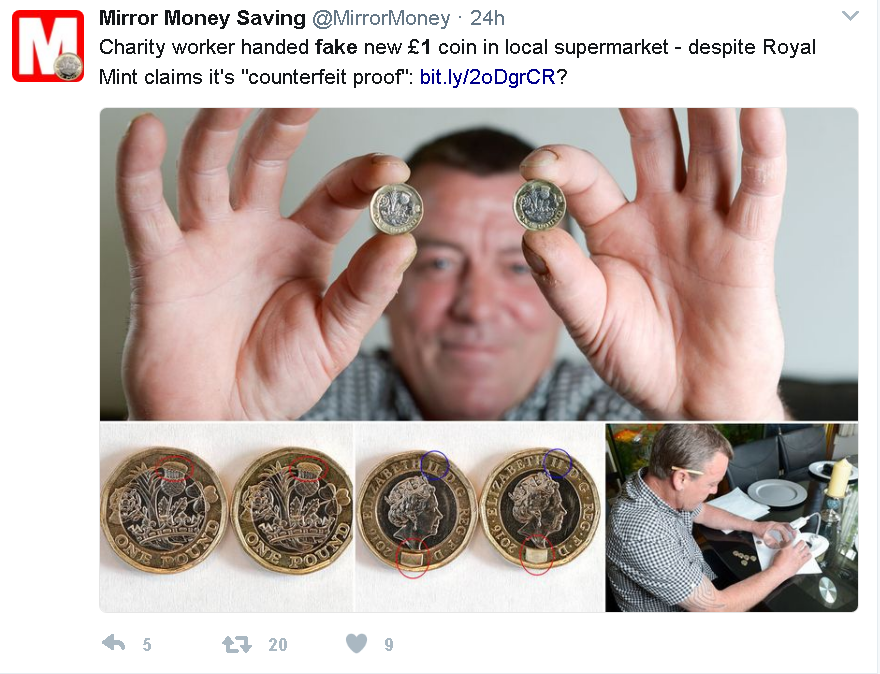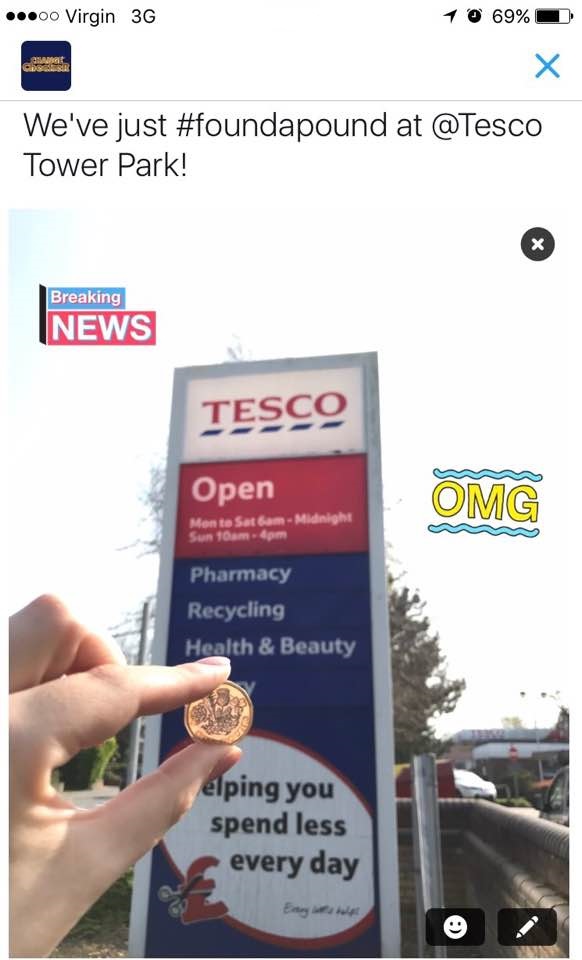Posts Tagged ‘The Royal Mint’
Rumours of fake £1 coins denied by Royal Mint
The Royal Mint has denied claims that there are already counterfeit 12-Sided £1 coins in circulation after a charity worker pointed out discrepancies between two coins.
Roy Wright, a charity worker from Surrey, was shocked when he noticed a few subtle differences between the two £1 coins, leading him to believe he had found the ‘first fake £1 coin’.
Impossible to counterfeit
Despite the new £1 coins being designed to be ‘impossible to counterfeit’, Mr Wright suggested that coin he had was heavier, had no hologram and the Queen’s head was positioned more to the left. Not only that, the edges were more rounded and there was no detail on the head of the thistle.
A genuine coin with a production fault…
Whilst the story has caused some excitement in the press and The Royal Mint has not yet been able to examine the offending coin, they are confident it is not a fake, but instead a genuine coin with a production fault.
Despite tight quality controls being in place, The Royal Mint has said that variances are likely to occur during the striking process in a small numbers of coins. Whilst such mis-strikes are relatively unusual and can be numismatically interesting, they are not the same as genuine errors.
Rumours of a genuine error in circulation
Unconfirmed rumours have also been circulating about some new £1 coins featuring two dates. There are reports of some coins having 2016 on the obverse and 2017 engraved in the micro lettering of the reverse.
Although, we are yet to see an example, if this is true, it would have to be the result of mis-matched 2016 and 2017 dies being used during production – a genuine error or “mule”.
Of course, it was the use of an incorrect die that resulted in the most famous modern “error” – the “undated 20p coin“, now regarded by many as the Holy Grail of change collecting. You can read more about the story of the undated 20p here.
If you’ve #foundapound in your change, have you spotted anything strange about it?
Poll: What is your favourite £1 Coin Design? – England
 As part of the Great One Pound Coin Race, we want to find out Britain’s ultimate favourite £1 coin.
As part of the Great One Pound Coin Race, we want to find out Britain’s ultimate favourite £1 coin.
Last week we asked you to vote for your favourite Welsh £1 coin design – it was very close but 35% of Change Checkers voted the 2013 Daffodil and Leek £1 as their favourite.
This week we want to know your favourite English £1 coin design.
Let us know by voting in our poll below:
More information about the English £1 coin designs
The first reverse design series of £1 coins took floral emblems as its theme to represent the United Kingdom and its four constituent countries. They were designed by Leslie Durbin – one of the most highly-regarded silversmiths of the 20th Century. The Oak Tree is used on this coin to represent England.
The second series of £1 coin designs used heraldic emblems to represent the United Kingdom and its four constituent countries. This coin features three lions to represent England. The three lions date back to Richard the Lionheart (1189-1199) who used three golden lions on a scarlet background as a powerful symbol of the English throne.
The third series of £1 coin designs depicts bridges from each of the four consituent countries in the United Kingdom. This coin features the Gateshead Millennium Bridge to represent England. The Gateshead Millennium Bridge is a tilt bridge which spans the River Tyne between Gateshead and Newcastle. It is the world’s first tilting bridge and has won a large number of awards for its design and lighting.
The fourth series of £1 coins used the capital cities of the four constituent countries as the basis of the reverse design. Designed by Stuart Devlin, Goldsmith and Jeweller to the Queen, this coin depicts the circular Coat of Arms of the City of London as the principal focus to represent England.
The fifth series of £1 coin designs uses pairs of floral emblems designed by Timoty Noad to represent the United Kingdom and its four constituent countries. This coin features an oak branch with an acorn alongside a stem with a tudor-inspired rose to represent England
Next week- Final: What’s your ultimate favourite £1 coin design?
 This could be your last chance to secure Britain’s last ’round pound’.
This could be your last chance to secure Britain’s last ’round pound’.
If you want to get your hands on the last ‘round pound’ they are available here protectively encapsulated and certified as superior Brilliant Uncirculated quality.
Why the 2016 £1 coin is about to become the latest coin collecting myth
The Royal Mint have confirmed that more than half a billion of the new £1 coins that have been released into circulation will be dated 2016.
But you may have also seen in the news that if you find one with a 2016 date, it could be one of the handful of ‘uniquely flawed coins’ and may be worth £250.
Unfortunately that isn’t the case.
Coins are typically struck with dies with that year’s date on, and as 1.5 billion new coins were required for the launch of the new 12-sided £1 coin, The Royal Mint started striking them in March 2016. That means that all of the new 12-sided £1 coins that were produced last year will have the 2016 date on them.
Will the 2016 12-sided £1 coins be rare?
In short, no. With half a billion 2016 dated £1 coins in circulation, they should be relatively easy to get hold of. In fact, we are yet to see someone who has found a 2017 dated £1 in their change.

Over half a billion 2016 dated £1 coins have been released into circulation. So far the only 2017 dated £1 coins we have seen are the Brilliant Uncirculated collector versions.
If we take a look back to the mintage figures in 1983 when the £1 coin was first introduced, in total 443,053,510 of the Royal Arms £1 coin were struck for circulation that year. That’s a little less than the amount of 2016 dated £1 coins and nearly 3 times less than the total amount of of the new coins struck for launch.
Considering 1983 was a time without contactless payments and when cash was the most used method of payment, 443,053,510 seems a relatively small amount in comparison to the 1.5 billion required for the new 12-sided £1 coin launch.
1997 Maklouf ‘Queen with a Necklace’ £2
You may remember the collecting frenzy that the ‘Queen with a Necklace’ £2 coin caused in 1998 when the brand new bi-metallic coin was introduced into circulation.
The ‘Queen with a Necklace’ £2 has an enduring legacy in the collecting world as the very first bi-metallic £2 coins issued just prior to the Queen’s portrait change in 1998. This meant that the older portrait by Raphael Maklouf was only used for one year: 1997. His version featured Queen Elizabeth II wearing a necklace, which is how the nickname was derived.
When the portrait change was announced, the new £2 coins were snapped up by collectors believing them to be a future rarity. As it turned out, a mintage of nearly 14 million means the ‘Queen with a Necklace’ £2 is not one of the rarest coins in circulation. Nevertheless, with only one year of issue, it still holds an undeniable interest for collectors.
An undeniable interest for collectors.
And the same can be said for the 2016 dated £1 coin. Although the £1 is in no way a rarity, first year of issue coins are always more sought after in years to come. As the new coin is Britain’s first 12-sided £1 and it is the first specification change to our £1 coin in more than 3 decades, the new 2016 dated £1 should hold a significant place in any coin collection.
#foundapound
To celebrate the release of the new 12-sided £1 coin, we’re giving away FIVE ‘Nations of the Crown’ Silver Proof 12-Sided £1 Coins!
For your chance to WIN a Silver Proof £1, all you need to do is find one of the new 12-sided £1 coins in your change…
Post a photo via Facebook, Twitter or Instagram using the hashtag #foundapound and the location you found your first £1 coin.
We’ll then choose 5 winners at random on the 10th April.
It’s really that easy – so good luck and get posting! #foundapound









